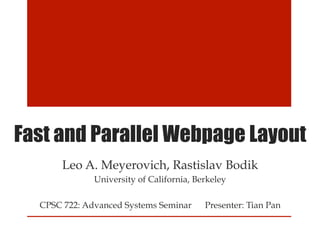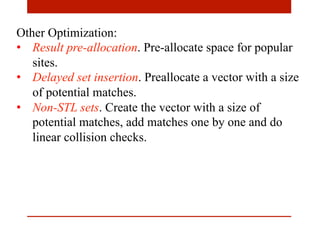Fast and Parallel Webpage Layout
- 1. Fast and Parallel Webpage Layout ? Leo A. Meyerovich, Rastislav Bodik University of California, Berkeley CPSC 722: Advanced Systems Seminar Presenter: Tian Pan
- 2. Let¡¯s get started with a story¡ in June, 2012 Facebook¡ NYTimes: Facebook to rewrite their iOS app BBC: Facebook recodes iOS mobile app to address speed complaints Guardian: Facebook doubles iPhone app speed by dumping HTML5 for native code ¡
- 3. There are 85,000 + iPhone applications in the same situation: refactoring existing UI / rewrite clients completely + downloaded over 2 billion times - cover less than 1% of online content
- 4. So we still need: A browser supporting emerging and diverse class of mobile devices However, - limited CPU computational resources. - The power wall forces hardware architects to apply increases in transistor counts towards improving parallel performance, not sequential performance. A fast and parallel mobile browser
- 5. Outline 1.? Problem and background 2.? Challenges 3.? Solutions 4.? Conclusion
- 6. Data flow in a browser
- 7. Where are the bottlenecks in loading a page? Lower bounds on CPU times for loading popular pages (Laptop)
- 8. Where are the bottlenecks in loading a page? Lower bounds on CPU times for loading popular pages (Laptop) Layout matching and rendering (34%)
- 9. Input Output HTML tree Absolute element positions Fonts CSS Layout matching and rendering (34%)
- 10. Layout matching and rendering steps Categories I.? Selector matching step 1 II.? Box and text layout step 2, 4, 5, 6 III.? Glyph handling step 3 IV.? Painting or rendering step 7
- 11. Where are the bottlenecks in layout matching and rendering? 3 < 2 <1 1. CSS selector matching Challenges: 2. Box and text layout solving 3. Glyph rendering
- 12. Outline 1.? Problem and background 2.? Challenges 3.? Solutions 3.1. CSS selector matching 3.2. Box and text layout 3.3. Glyph rendering 4.? Conclusion
- 13. 3.1 CSS Selector Matching Match CSS rules with HTML nodes p img { margin: 10px; } Selector Style constraints <p> <img blahblah> </p> DOM node with CSS rules
- 14. attributes rules id1 r1 id id2 r2 hash table ¡ ¡ Selector {Rules} ¡id1 r1 ¡id2 r2 attributes rules class1 r3 ¡class1 r3 class ¡tag1 r4 class2 r5 class3 r6 hash table ¡class2 r5 ¡class3 r6 ¡ ¡ ¡ ¡ attributes rules CSS tag tag1 r4 a list of selector{rules} hash table ¡ ¡
- 15. attributes rules node rules id1 r1 n2 r1 node attributes node rules id2 r2 n1 r2 n1 id2 ¡ ¡ ¡ ¡ n1 r2 class2 ¡ ¡ r5 class3 attributes rules ¡ ¡ r6 tag1 class1 r3 n3 r3 r4 class2 r5 n1 r5 n2 id1 n1 r6 n2 r1 class3 r6 tag1 ¡ ¡ ¡ ¡ r4 n3 class1 ¡ ¡ n3 r4 ¡ ¡ ¡ ¡ ¡ ¡ attributes rules n1 r4 tag1 r4 n3 r4 HTML nodes ¡ ¡ Map Reduce
- 16. Optimizations adopted by WebKit: ?? Hashtables. [¡Á] check CSS repeatedly for every node [¡Ì] read only once, build hashmap, and check hash ?? Right-to-left matching. Most selectors can be matched by only examing a short suffix of the path. Other Optimization: ?? Hash Tiling. partition the hashtable to idHash, classHash, tagHash, ¡ for reducing cache misses. (Also could have been parallel.) ?? Tokenization. store attributes as int of tokens instead of string to save cache and comparison time. ?? Random load balancing. Allocate selectors matching randomly instead of sequentially as origin.
- 17. Other Optimization: ?? Result pre-allocation. Pre-allocate space for popular sites. ?? Delayed set insertion. Preallocate a vector with a size of potential matches. ?? Non-STL sets. Create the vector with a size of potential matches, add matches one by one and do linear collision checks.
- 18. 3.1 CSS Selector Matching Evaluation Cilk++: Overall 13x and 14.8x with and without Gmail Intel TBB: Overall 55.2x and 64.8x with and without Gmail Workstation: 204ms -> 3.5ms Handheld: 3000ms ->50ms
- 19. 3.2 Box and text layout Input: HTML tree nodes with symbolic constraint attributes Output: actual layout details (size, shape, position) waiting to be painted into pixels Layout constraints input Layout constraints output
- 20. Unfortunately, it is hard to optimize, because CSS ?? Informal written and cross-cutting, e.g. infinite loops ?? Confusing for webpage designers ?? Need standards-compliant engines
- 21. Berkeley Style Sheets (BSS) A new, more orthogonal, concise, well-defined intermediate layout language ?? Transformed from CSS ?? Specified with an attribute grammar (chances for parallelization) ?? BSS0 (vertical and horizontal boxes), BSS1 (BBS0+shrink-to-fit sizing), BSS2 (BBS1+left floats)
- 22. BSS0 (vertical and horizontal boxes)
- 23. Attribute Grammars O(log|tree|) attrA Potential for parallelization S9 attrB n1 attrC n2 n3 S7 S8 n4 n5 n6 n7 attrD attrE attrF attrG S3 S4 S5 S6 calcSynthesized() attrA attrA IattrA IattrA attrB attrC S1 S2 S3 S4 S5 S6 IattrA IattrA IattrA IattrA S3 S4 S5 S6 IattrB IattrB IattrB IattrB attrD attrE attrF attrG calcInherited() attr: attribute Iattr: inherited attribute S: synthesized attribute
- 24. 3.2 Layout Constraint Solving Evaluation Slashdot.org, BSS1, Cilk++: 3x~4x
- 25. 3.3 Glyph Rendering Till now, the size and position of texts have been calculated. How to render these texts? Parallel and locality benefits requests request groups pull and render
- 26. 3.3 Glyph Rendering Evaluation FreeType2 font library, TBB: 3x~4x
- 27. 4 Conclusion Address three bottlenecks of loading a page 1.?CSS selector matching ?? Pre-built hash tables, map-reduce 2. Box and text layout solving ?? Specify layout as attribute grammars 3. Glyph rendering ?? Combine requests to groups and render in parallel Milestone in building a parallel and mobile browser
- 28. Thanks~
















![Optimizations adopted by WebKit:
?? Hashtables. [¡Á] check CSS repeatedly for every node
[¡Ì] read only once, build hashmap, and check hash
?? Right-to-left matching. Most selectors can be matched
by only examing a short suffix of the path.
Other Optimization:
?? Hash Tiling. partition the hashtable to idHash,
classHash, tagHash, ¡ for reducing cache misses.
(Also could have been parallel.)
?? Tokenization. store attributes as int of tokens instead
of string to save cache and comparison time.
?? Random load balancing. Allocate selectors matching
randomly instead of sequentially as origin.](https://image.slidesharecdn.com/tianpan-fplayout-121120145543-phpapp01/85/Fast-and-Parallel-Webpage-Layout-16-320.jpg)











